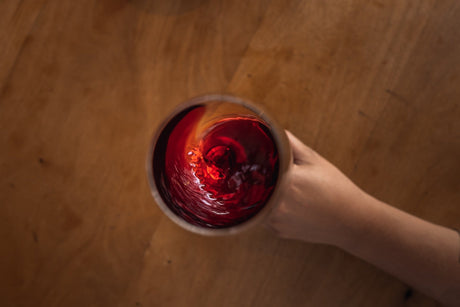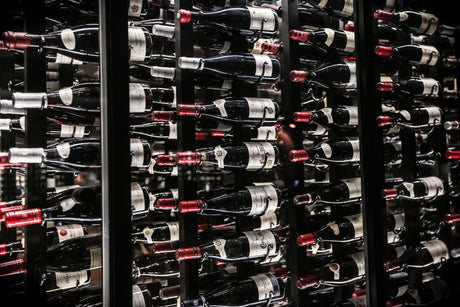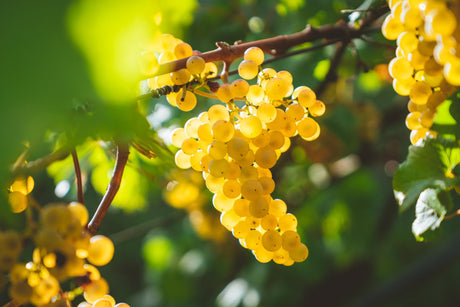
Mastering The Art of Decanting Wine: A Beginner's Guide
Don't be intimidated by decanting wine - it's not just for snobs! Learn why and how to do it with this fun, beginner-friendly guide from Your Wines. Cheers to better-tasting...
The Willows Vineyard
The Willows Vineyard Riesling 2024 (12 bottles)
Adelina
Adelina Smith Family Vineyard Polish Hill Riesling 2023 (12 Bottles)
Plantagenet
Plantagenet Wyjup Collection Riesling 2022 (12 Bottles)
Plantagenet
Plantagenet Museum Riesling (Limited) 2014 (12 Bottles)
Plantagenet
Plantagenet Three Lions Riesling 2023 (12 Bottles)
Pauletts
Pauletts Aged Release Polish River Riesling 2017 (12 Bottles)
Pauletts
Pauletts Polish Hill River Riesling 2023 (12 Bottles)
Pauletts
Pauletts Clare Valley Missy “Off Dry” Riesling (Vegan) 2021 (12 Bottles)
Pauletts
Pauletts Clare Valley Riesling (Vegan) 2023 (12 Bottles)
Bethany Wines of Barossa
Bethany First Village Late Harvest Riesling (500ml) 2023 (12 Bottles)
Bethany Wines of Barossa
Bethany First Village Riesling Eden Valley 2023 (12 Bottles)
Josef Chromy
Josef Chromy Riesling, Tasmania 2023 (12 bottles)
Josef Chromy
Josef Chromy SGR Delikat Riesling, Tasmania 2020 (12 bottles)
Hentley Farm
Hentley Farm Riesling, Eden Valley 2024 (12 bottles)
Giesen
Giesen Estate Riesling, Marlborough 2023 (12 bottles)
Framingham
Framingham 'F Series', Riesling, Marlborough 2021 (12 bottles)
Framingham
Framingham Classic Riesling, Marlborough 2023 (12 bottles)
Whether you're a seasoned connoisseur or a curious explorer of Riesling, our collection caters to all palates. At Your Wines, we take pride in presenting an array of meticulously curated wines from top Australian and International producers, each bottle telling a story of craftsmanship and tradition.
Q: What defines Riesling as a white wine grape variety?
A: Riesling is a versatile white grape variety known for its high acidity and expressive aromatics. It produces a wide range of styles, from bone-dry to lusciously sweet, and is cultivated in various wine regions around the world.
Q: What are the key characteristics of Riesling wine?
A: Riesling wine is recognised for its crisp acidity, aromatic profile, and diverse range of flavours. It can exhibit notes of citrus, stone fruits, flowers, and, in some cases, mineral undertones. The wine's sweetness level varies, making it appealing to a broad audience.
Q: How is Riesling pronounced?
A: Riesling is pronounced "REEZ-ling." The emphasis is on the first syllable, and the "g" is silent.
Q: What distinguishes Riesling from Adelaide Hills?
A: Adelaide Hills Riesling is celebrated for its vibrant acidity, intense citrus, and floral aromas. The region's cool climate contributes to the wine's elegance and purity of fruit.
Q: How is Riesling characterised in Margaret River?
A: Riesling from Margaret River is known for its lively acidity and citrus-driven flavours. The maritime influence in the region contributes to wines with a refreshing and crisp profile.
Q: What makes Riesling from Yarra Valley unique?
A: Yarra Valley Riesling is admired for its delicate and restrained style. These wines often showcase citrus and green apple notes focusing on finesse and balance.
Q: How is Riesling expressed in the Great Southern region?
A: Great Southern Riesling is known for its versatility, displaying a spectrum of styles from bone-dry to sweet. The region's diverse subzones contribute to wines with varying flavours, often including lime, lemon, and floral notes.
Q: What can one expect from Riesling produced in Tasmania?
A: Tasmania's cool climate produces Riesling with crisp acidity and expressive fruit flavours. These wines may feature citrus, green apple, and sometimes riper fruit notes, creating a refreshing and vibrant profile.
Q: What sets Eden Valley Riesling apart?
A: Eden Valley, a subregion of the Barossa, is renowned for producing Rieslings with intense flavours, high acidity, and distinct mineral character. The elevated vineyards contribute to the wine's complexity.
Q: How is Riesling expressed in Clare Valley?
A: Clare Valley Riesling is known for its vibrant acidity and pronounced lime and citrus flavours. The region's warm days and cool nights contribute to the grape's slow ripening, resulting in wines with depth and balance.
Q: What makes German Riesling unique?
A: German Riesling is highly regarded for its quality and diversity. It can range from bone-dry (Trocken) to sweet (Spatlese, Auslese, etc.). German Rieslings often showcase floral and fruity aromatics with a strong sense of terroir.
Q: How does French Riesling differ from other regions?
A: French Riesling, particularly from the Alsace region, is often dry and full-bodied. Alsace Rieslings can exhibit ripe fruit flavours, floral aromas, and a rich texture, showcasing the region's unique terroir.
Q: What defines Late Harvest Riesling?
A: Late Harvest Riesling is a sweet style made from grapes left on the vine longer to achieve higher sugar levels. These wines can range from off-dry to lusciously sweet, often displaying concentrated fruit flavours.
Q: Which regions in Australia produce the best Riesling?
A: Some of the best Riesling in Australia come from regions like Clare Valley, Eden Valley, and Great Southern. These regions are known for their diverse expressions of Riesling, ranging from crisp and dry to sweet styles.
Q: What is the origin of the Riesling grape?
A: Riesling originated in the Rhine region of Germany. It is now grown in various wine regions globally, including Germany, France, Australia, and the United States.
Q: How would you describe the taste of Riesling wine?
A: Riesling can exhibit various flavours, from crisp citrus and green apples to tropical fruits and floral notes. The wine's taste profile is influenced by region, winemaking style, and sweetness level.
Q: Is Riesling always a sweet wine?
A: No, Riesling can be made in various styles, ranging from bone-dry to sweet. The sweetness level is determined by factors such as grape ripeness at harvest and winemaking choices.
Q: Can Riesling be dry?
A: Yes, Riesling can be crafted in a dry style. Many regions, including Germany and Australia, produce dry Rieslings that showcase the grape's natural acidity and vibrant fruit flavours.
Q: What is the reason behind the unique bottle shape used for Riesling?
A: The tall and slender Riesling bottle shape is traditional in Germany and Alsace. It is believed to showcase the wine's colour and clarity, and the upright shape helps prevent sediment from settling in the wine.
Q: How do Riesling and Moscato differ in taste and characteristics?
A: Riesling and Moscato are distinct grape varieties with different flavour profiles. While both can exhibit sweetness, Riesling is known for its acidity and diverse flavour range, while Moscato often displays floral and muscat grape aromatics.
Q: Does Riesling have ageing potential?
A: Yes, Riesling is known for its ageing ability. High-quality dry Rieslings and some late harvest styles can evolve gracefully over time, developing complex flavours and a rich texture.
Q: Is Riesling suitable for cooking?
A: Yes, Riesling is a versatile wine for cooking. It's acidity and nuanced flavours make it an excellent choice for enhancing the taste of dishes, especially those with seafood, poultry, and light sauces.
Q: What types of food pair well with Riesling?
A: Riesling pairs well with various foods due to its acidity and versatility. It complements seafood, spicy dishes, salads, and dishes with citrus-based sauces. It's also a great match for Asian cuisine.
Q: When is the best time to drink Riesling?
A: Riesling can be enjoyed young for its fresh and vibrant qualities, but high-quality examples, especially those with some sweetness, can age well. Consider drinking young, crisp Rieslings for their primary fruit flavours and aged ones for added complexity.
Q: What is the recommended way to serve Riesling?
A: Serve Riesling chilled, typically around 8-10°C (46-50°F) for dry and slightly colder for sweeter styles. The cool temperature enhances the wine's refreshing qualities and allows its aromas to shine.
Whether you're longing for a crisp, dry Riesling to accompany your meal or a sweet late-harvest delight for dessert, there's a Riesling for every palate and every plate. Delve into the world of this fascinating varietal and watch your love for wine grow with every sip. Cheers!

Don't be intimidated by decanting wine - it's not just for snobs! Learn why and how to do it with this fun, beginner-friendly guide from Your Wines. Cheers to better-tasting...

Bored with the same old Pinot Noir? These five alternative red wines share some characteristics of your favourite Pinot but also bring something new to spice things up. Cheers to...

Want to impress your friends with some fancy wine tricks? Look no further! From quick chilling methods to uncorking without a corkscrew, these clever tips will elevate your wine game....

Spice up your New Year's Eve celebrations with our list of the best sparkling wines Australia has to offer. From crisp and refreshing to full-bodied and complex, find your perfect...

Who says sparkling wine is just for special occasions? Discover 5 fun and unexpected pairings that elevate your everyday Aussie snacking experience. Cheers!

Join us on an adventure to uncover the history and allure behind Australia's love for Shiraz. From its bold flavours to its global recognition, discover why this wine reigns supreme...

Are you a Chardonnay lover looking to expand your wine horizons? Check out these top five alternative white wines that are sure to impress your palate and liven up any...

Who says celebrations have to be expensive? Check out these five pocket-friendly sparkling wine suggestions that will make your taste buds dance. Perfect for holidays, special occasions, or just a...

Get ready to sip your way into summer with these amazing wine pairings for seafood dishes! Find out which wines will perfectly accompany all your favourite dishes.